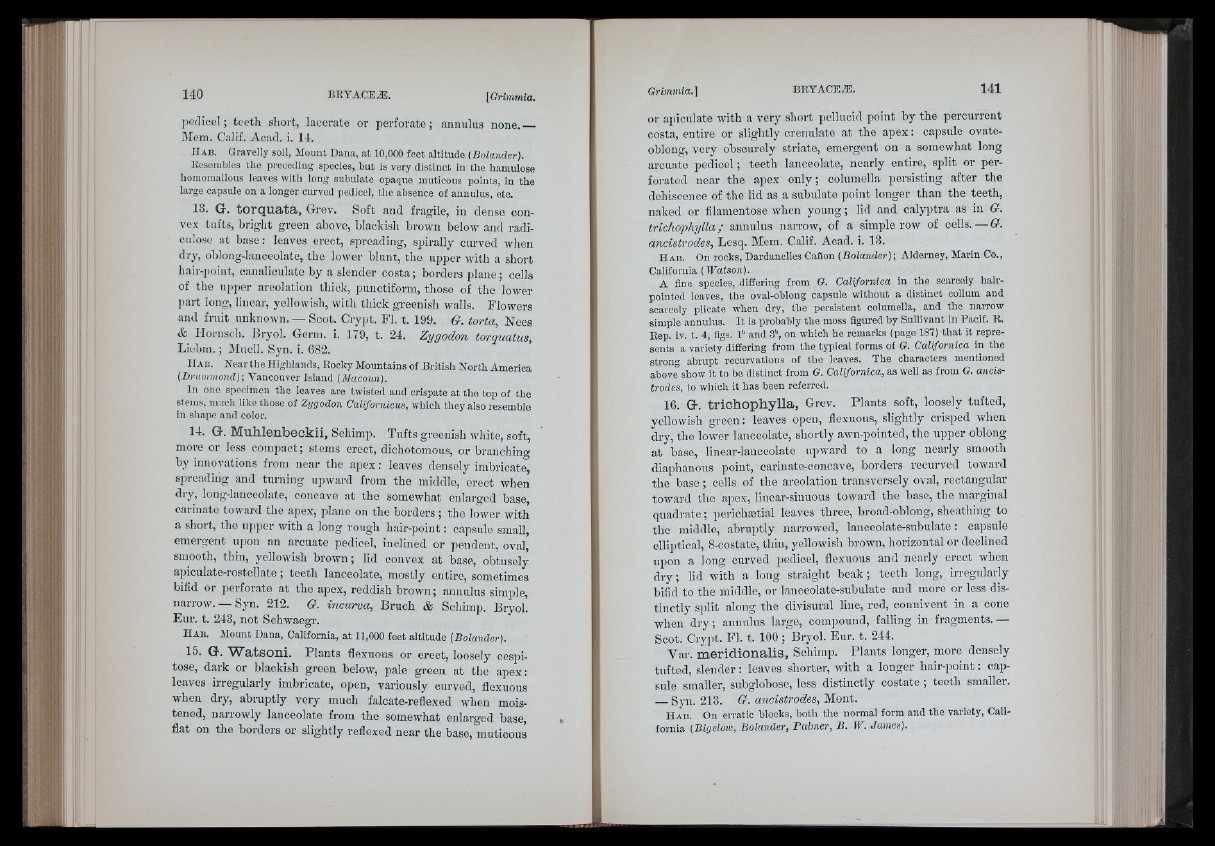
j/edícel; teeth short, lacerate or perforate; annulus none.—
Mem. Calif. Acad. i. 14.
H a b . Gravelly soil, Mount Dana, at 1 0 ,0 0 0 feet altitude (Bolander).
Resembles the preceding species, but is very distinct in the hamulose
homoinailous leaves with long subulate opaque muticous points, in the
large capsule on a longer curved pedicel, the absence of annulus, etc.
13. G. to rq u a ta , Grev. Soft and fragile, in dense convex
tufts, bright green above, blackish brown below and radiculose
at base: leaves erect, spreading, spirally curved when
dry, ohlong-lanceolate, the lower blunt, the upper with a short
hair-point, canaliculate by a slender costa; borders plane; cells
of the upper areolation thick, punotiform, tliose of the lower
part long, linear, yellowish, with thick greenish walls. Flowers
and fruit unknown. — Scot. Crypt. FI. t. 199. G. torta, Nees
& Ilornsch. Bryol. Germ. i. 179, t. 24. Zygodon torquatus,
Liebm.; Muell. Syn. i. 682.
Hac. Near the Highlands, Rocky Mountains of British North America
{lli-iunmond); Vancouver Island (Macoim).
In one specimen the leaves are twisted and crispate at the top of the
stems, mucll like tliose of Zygodon Californlcus, which they also resemble
in shape and color.
14. G. Muhlenbeckii, Schimp. Tufts greenish white, soft,
more or less compact; stems erect, dichotomous, or branching
by innovations from near the apex: leaves densely imbricate,
spreading and turning upward from the middle, erect when
dry, long-lanceolate, concave at the somewhat enlarged base,
carinate toward the apex, plane on the borders; the lower with
a short, the upper with a long rough hair-point: capsule small,
emergent upon an arcuate pedicel, inclined or pendent, oval,
smooth, thin, yellowish brown; lid convex at base, obtusely
apiculate-rostellate ; teeth lanceolate, mostly entire, sometimes
bifid or perforate at the apex, reddish brown; annulus simple,
narrow. — Syn. 212. G. incurva, Bruch & Schimp. Bryol.
Eur. t. 243, not Schwaegr.
Hab. Mount Dana, California, at 1 1 ,0 0 0 feet altitude (Bolander).
15. G. W a ts o n i. Flants flexuous or erect, loosely cespitose,
dark or blackish green below, pale green at the apex:
leaves irregularly imbricate, open, variously curved, flexuous
when dry, abruptly very much falcate-reflexed when moistened,
narrowly lanceolate from the somewhat enlarged base,
flat on the borders or slightly reflexed near the base, muticous
or apiculate with a very short pellucid point by the percurrent
costa, entire or slightly crenulate at the apex : capsule ovate-
oblong, very obscurely striate, emergent on a somewhat long
arcuate pedicel ; teeth lanceolate, nearly entire, split or perforated
near the apex only; columella persisting after the
dehiscence of the lid as a subulate point longer than the teeth,
naked or filamentose when young ; lid and calyptra as in G.
trichophylla / annulus narrow, of a simple row of cells.—G.
ancistrodes, Lesq. Mem. Calif. Acad. i. 13.
Hae. On rocks, Dardanelles Cañón (Bolander) ; Alderney, Marin Co.,
California (IFaisoii).
A fine species, differing from O. Californlca in the scarcely hair-
pointed leaves, the oval-oblong capsule without a distinct collum and
scarcely plicate when dry, the persistent columella, and the narrow
simple annulus. It is probably the moss figured by Sullivant in Pacif. R.
Eep. iv. t. 4, figs. I' and 3', on which he remarks (page 187) that it represents
a variety differing from the typical forms of G. Californlca in the
strong abrupt recnrvations of the leaves. The characters mentioned
above show it to be distinct from G. Californica, as well as from G. ancistrodes,
to which it has been referred.
16. G. tr ic h o p h y lla , Grev. Flants soft, loosely tufted,
yellowish green: leaves open, flexuous, slightly crisped when
dry, the lower lanceolate, shortly awn-pointed, the upper oblong
at base, linear-lanceolate upward to a long nearly smooth
diaphanous point, carinate-concave, borders recurved toward
the base ; cells of the areolation transversely oval, rectangular
toward the apex, linear-sinuous toward the base, the marginal
quadrate ; perichætial leaves three, broad-oblong, sheathing to
the middle, abruptly narrowed, lanceolate-subulate: capsule
elliptical, 8-costate, thin, yellowish brown, horizontal or declined
upon a long curved pedicel, flexuous and nearly erect when
dry; lid with a long straight beak; teeth long, irregularly
bifid to the middle, or lanceolate-subulate and more or less distinctly
split along the divisural line, red, connivent in a cone
when dry; annulus large, compound, falling in fragments.—
Scot. Crypt. FI. t. 100 ; Bryol. Eur. t. 244.
Var. m e r id io n a lis , Schimp. Flants longer, more densely
tufted, slender : leaves shorter, with a longer hair-point : capsule
smaller, subglobose, less distinctly costate ; teeth smaller.
Syn. 213. G. ancistrodes, Mont.
Hab. On erratic blocks, both the normal form and the variety, California
(Bigeloxo, Bolander, Palmer, B. W. James).